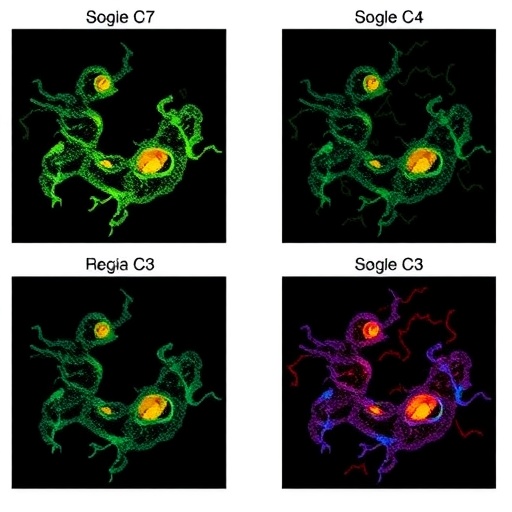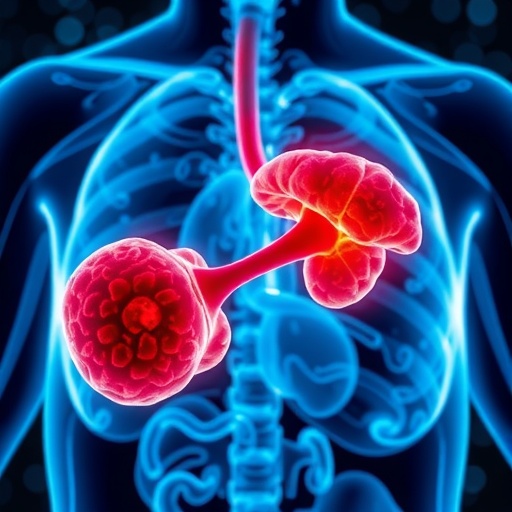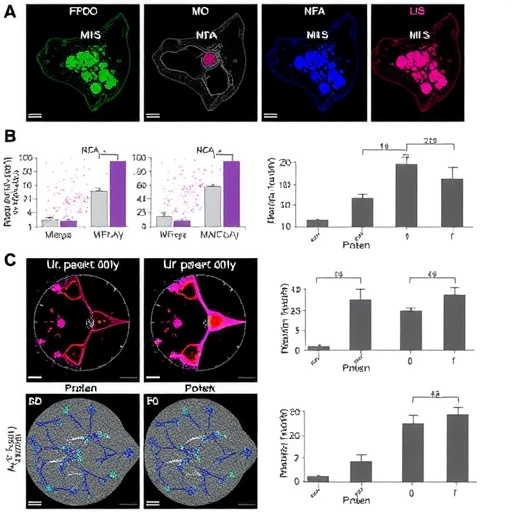
Gastric signet ring cell carcinoma (GSRCC) represents a formidable challenge in the field of oncology due to its aggressive behavior and distinctive molecular profile. Unlike other gastric cancer subtypes, GSRCC displays unique pathological and epidemiological traits, complicating both diagnosis and treatment. The scarcity of comprehensive proteomic research into this cancer variant has impeded the development of targeted therapeutic strategies. However, a groundbreaking study has now leveraged sophisticated mass spectrometry (MS)-based proteomics to unravel the molecular intricacies of GSRCC, offering unprecedented insights into its biology and potential vulnerabilities.
The international research consortium behind this study employed an integrated proteomic approach to analyze tumor tissues from 112 patients diagnosed with GSRCC, each featuring a significant signet ring cell composition exceeding 70%. Their proteomic investigation cataloged an extensive repertoire of 7,322 proteins, culminating in the construction of the most comprehensive peptide spectral library specific to GSRCC to date. This expansive dataset provides a crucial resource for decoding the tumor’s biology at the protein level, which often reveals functional dynamics obscured by genomic and transcriptomic analyses alone.
Central to the study’s findings is the identification of four novel proteomic subtypes of GSRCC, each defined by distinct molecular signatures reflective of critical biological processes. These subtypes—Metabolism (S-Mb), Microenvironment Dysregulation (S-Me), Migration (S-M), and Proliferation (S-PF)—were delineated through unsupervised clustering techniques, highlighting profound heterogeneity within GSRCC tumors. This stratification illuminates how differential protein expression patterns underpin varied clinical outcomes, underscoring the necessity for subtype-specific therapeutic approaches.
An innovative aspect of the investigation involved correlating proteomic subtypes with clinical survival data using sophisticated statistical models. The Cox proportional hazards regression and Kaplan-Meier survival analyses collectively substantiated the prognostic relevance of the newly established subtypes. Particularly, patients harboring tumors within the Proliferation subtype experienced poorer survival, suggesting that protein expression profiles can serve as potent prognostic biomarkers, guiding clinicians in risk stratification and personalized treatment planning.
Notably, the study also spotlighted two proteins as independent prognostic biomarkers validated in a separate patient cohort. Peroxiredoxin-2 (PRDX2), an antioxidant enzyme, was associated with favorable survival outcomes, whereas DEAD-box helicase 27 (DDX27) correlated with adverse prognosis. These biomarkers augment the current molecular toolkit for GSRCC, offering promising candidates for clinical assays and potential therapeutic targets. Their functional roles in oxidative stress responses and RNA metabolism, respectively, implicate fundamental cellular pathways driving tumor behavior.
Further refining the landscape of tumor heterogeneity, the authors examined proteomic profiles of 79 biomarker-negative GSRCC cases. This subgroup analysis unveiled three distinct proteomic clusters, among which one cluster exhibited notably aggressive clinical features and dismal survival rates. Such findings reflect the complex intratumoral diversity that could impact treatment efficacy and resistance mechanisms, reinforcing the imperative for comprehensive molecular classification in this cancer subtype.
Delving deeper into the molecular target landscape, the research focused on a clinically challenging subset characterized by negativity for HER2, Epstein-Barr virus (EBV), and proficient mismatch repair (pMMR)—coined as LMT-GSRCC (Lack of Medical Treatment). In this subgroup, the study discovered elevated expression of components involved in protein synthesis and immune signaling: EIF2S3, EIF6, and NFKB2. Each of these proteins has been implicated in oncogenic pathways, sustaining tumor growth and survival. Their association with poor prognosis positions them as attractive candidates for therapeutic intervention.
Strikingly, the study leveraged in silico molecular docking, cytotoxicity assays, and preclinical models to identify neratinib—an FDA-approved tyrosine kinase inhibitor initially used in breast cancer—as a potent inhibitor of these target proteins. This drug effectively suppressed tumor proliferation, migration, and invasion in both cell culture and animal models, while inducing apoptosis with minimal toxicity. The repositioning of neratinib for GSRCC reflects a burgeoning paradigm in oncology, harnessing existing pharmaceuticals to expedite treatment availability and reduce development costs.
The translational impact of these results is profound. By delineating molecular subtypes and actionable targets within GSRCC, the study paves the way for precision medicine approaches tailored to the unique proteomic landscape of each tumor. This paradigm shift holds promise for improving patient stratification, optimizing therapeutic regimens, and ultimately enhancing clinical outcomes in a cancer subtype historically refractory to standard therapies.
Moreover, the integration of advanced MS-based proteomics with clinical annotations exemplifies the power of systems biology in cancer research. This holistic perspective captures not only aberrant protein expression but also functional pathway alterations, facilitating a more nuanced understanding of tumor biology. Such comprehensive molecular profiling is vital to overcoming the heterogeneity and complexity that characterize GSRCC and other malignancies.
While this investigation primarily focuses on the LMT-GSRCC subgroup, its methodological framework and findings provide a blueprint for similar analyses in diverse cancer types. The establishment of a detailed proteomic atlas will serve as a valuable reference for future studies aiming to elucidate tumor biology, discover biomarkers, and identify novel drug targets, thereby accelerating therapeutic innovation.
In conclusion, this seminal study marks a significant advancement in the molecular understanding of gastric signet ring cell carcinoma. By deploying state-of-the-art proteomic technology, the researchers have uncovered critical subtypes, prognostic markers, and therapeutic targets that collectively hold the potential to transform clinical management. As efforts continue to translate these findings into clinical practice, patients afflicted with this challenging cancer may soon benefit from more effective, personalized treatment options.
Subject of Research: Proteomic characterization and molecular subtyping of gastric signet ring cell carcinoma (GSRCC)
Article Title: A comprehensive proteomic analysis uncovers novel molecular subtypes of gastric signet ring cell carcinoma: Identification of potential prognostic biomarkers and therapeutic targets
References:
Jin Z, Yuan L, Ma Y, Ye Z, Zhang Z, Wang Y, Hu C, Dong J, Zhang X, Xu Z, Du Y, Guan X, Pan G, Tian S, Li J, Zhang R, Qin J, Cheng X. A comprehensive proteomic analysis uncovers novel molecular subtypes of gastric signet ring cell carcinoma: Identification of potential prognostic biomarkers and therapeutic targets. Genes Dis. 2025; DOI: 10.1016/j.gendis.2025.101717
Image Credits: Zhiyuan Jin, Li Yuan, Yubo Ma, Zu Ye, Zhao Zhang, Yi Wang, Can Hu, Jinyun Dong, Xinuo Zhang, Zhiyuan Xu, Yian Du, Xiaoqing Guan, Guangzhao Pan, Sichao Tian, Juan Li, Ruiwen Zhang, Jiangjiang Qin, Xiangdong Cheng
Keywords: gastric signet ring cell carcinoma, proteomics, mass spectrometry, molecular subtypes, biomarkers, therapeutic targets, neratinib, EIF2S3, EIF6, NFKB2, PRDX2, DDX27, tumor heterogeneity
Tags: aggressive cancer behavior analysiscomprehensive peptide spectral libraryGastric signet ring cell carcinomaintegrated proteomic approachmass spectrometry in oncologymolecular signatures in gastric cancernovel cancer subtypes discoverynovel therapeutic strategies for GSRCCproteomic profiling in cancerproteomic research challengestargeted therapies for GSRCCtumor biology and protein dynamics




